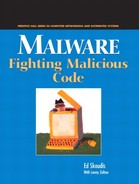Book Description
Reveals how attackers install malicious code and how they evade detection
Shows how you can defeat their schemes and keep your computers and network safe!
Details viruses, worms, backdoors, Trojan horses, RootKits, and other threats
Explains how to handle today's threats, with an eye on handling the threats to come
"This is a truly outstanding book-enormous technical wealth and beautifully written."
—Warwick Ford
"Ed does it again, piercing the veil of mystery surrounding many of the more technical aspects of computer security!"
—Harlan Carvey, CISSP
"This book is entertaining and informative, while justifiably scaring you. Luckily it also tells you how to protect yourself, but makes you realize it's going to be a permanent spy-vs-spy struggle."
—Radia Perlman, Distinguished Engineer, Sun Microsystems
Keep control of your systems out of the hands of unknown attackers
Ignoring the threat of malware is one of the most reckless things you can do in today's increasingly hostile computing environment. Malware is malicious code planted on your computer, and it can give the attacker a truly alarming degree of control over your system, network, and data-all without your knowledge! Written for computer pros and savvy home users by computer security expert Edward Skoudis, Malware: Fighting Malicious Code covers everything you need to know about malware, and how to defeat it!
This book devotes a full chapter to each type of malware-viruses, worms, malicious code delivered through Web browsers and e-mail clients, backdoors, Trojan horses, user-level RootKits, and kernel-level manipulation. You'll learn about the characteristics and methods of attack, evolutionary trends, and how to defend against each type of attack. Real-world examples of malware attacks help you translate thought into action, and a special defender's toolbox chapter shows how to build your own inexpensive code analysis lab to investigate new malware specimens on your own. Throughout, Skoudis' clear, engaging style makes the material approachable and enjoyable to learn. This book includes:
Solutions and examples that cover both UNIX® and Windows®
Practical, time-tested, real-world actions you can take to secure your systems
Instructions for building your own inexpensive malware code analysis lab so you can get familiar with attack and defensive tools harmlessly!
Malware: Fighting Malicious Code is intended for system administrators, network personnel, security personnel, savvy home computer users, and anyone else interested in keeping their systems safe from attackers.
Table of Contents
- Copyright
- Prentice Hall PTR Series in Computer Networking and Distributed Systems
- About Prentice Hall Professional Technical Reference
- Foreword
- Acknowledgments
- Introduction
- Viruses
- Worms
- Malicious Mobile Code
- Backdoors
- Trojan Horses
- User-Mode RootKits
- Kernel-Mode RootKits
- Going Deeper
- Scenarios
- Malware Analysis
- Conclusion
